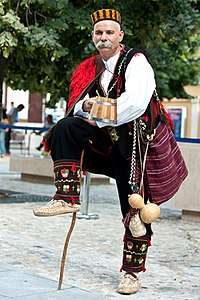Šibenik cap
Šibenik cap (Croatian: šibenska kapa) is a regional variant of a traditional red cap used in the Balkans that was developed in Šibenik, Croatia.

History
The cap is more orange in colour instead of red, and simplified in cut (without a conical top, flat from above). It is embroidered with characteristic black ornament and without any hanging appendixes. The cap was modified upon older traditional forms during a work time of Industry of Folk Embroidery (Croatian: Industrija narodnog veziva) held by Matavulj family in Croatian city of Šibenik from 1844 to 1945.[1]
The cap is well known throughout Croatia and is noticeable as a symbol of Šibenik and widely known among regional costume parts in general, not only representing Šibenik and its surroundings, but northern Dalmatia or a general Croatian identity when represented outside Croatia.
Šibenik cap is a tradition enlisted on the national intangible heritage list, in 2008.
See also
References
- Kale, Jadran (2009). "Rad 'Centra za unapredjenje domacinstva' u Sibeniku 1957.-1972." Ethnologica Dalmatica vol. 17, pp. 79-100.
Further reading
- Schubert, Gabriella (1993). Kleidung als Zeichen: Kopfbedeckungen im Donau-Balkan-Raum. Berlin: Harrassowitz Verlag.